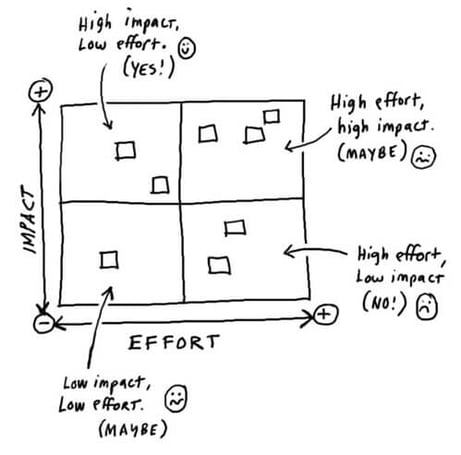+
Get in touch 👋🏽
We would love to hear from you.
Contact us to see how we can help.
We would love to hear from you.
Contact us to see how we can help.
What does a successful employee ideas campaign look like?
The answer may seem obvious: receiving a storm of high-quality ideas from employees across the business. This is often the dream scenario for innovation teams, and rightly so – from staff retention to new product revenue, there are endless benefits for companies that listen to their employees.
However, navigating the sea of employee ideas and finding the best ones can be all the more challenging when engagement levels are high. It becomes increasingly important to have a structured process for selecting one idea over another and a consistent framework by which to judge ideas.
.png?width=624&name=Innovation%20(1).png)
Enter the Expert Review. A powerful tool in the idea management toolbox and the final hurdle in many employee ideas campaigns. Sending your shortlist of ideas to be reviewed by a panel of subject matter experts (SMEs), and scored against a set of criteria, can be a superb method of identifying which ones should be brought to life.
Did you know?
82% of employees have ideas to improve their business, but 52% feel that good ideas fail to be implemented within their company
Lining up a panel of reviewers with expertise in your campaign field is the first step.
Every company will have their own concept of what a "good idea" should look like and choosing the right review criteria will enable your panel to unlock these hidden gems.
Pro-Tip
Tap into the knowledge of a wide pool of experts. Breadth of perspective is critical in the early stages of strategic innovation efforts
Source: The Inovo Group
To make the lives of your reviewers a little easier, your review criteria should be:
A strong review will include criteria around desirability, feasibility and viability.
Ideas cannot be evaluated in a vacuum; remind your reviewers to keep in mind the present state of the organisation and make realistic future predictions
Source: Board of Innovation
Pro-Tip
Include five to seven review questions to capture a well-rounded view of each idea, without leading to analysis paralysis. In an ideal world, it should only take 2-3 minutes to review each idea!
With all of this in mind, it can often be tricky to nail down the most effective review criteria to use on a campaign-by-campaign basis.
Here’s our list of seven tried and tested review criteria to help you in your search for the best employee ideas:

What is the likely benefit size of the idea?
Some ideas are worth their weight in gold. It goes without saying that most “good ideas”, if implemented, will bring some kind of benefit to your business. This could be a new revenue stream or a nifty saving in cost.
Even the simplest of ideas, such as changing the default print setting on the office printers to double-sided, can have a huge impact on company spend (not to mention the environment!).
Calculating the exact financial benefit size of an idea can be a difficult task, but you can provide your reviewers with value ranges and ask them to score each idea accordingly. For example:
1 = No / very low financial benefit
2 = £0 - £100k
3 = £100k - £500k
4 = £500k - £1m
5 = £1m+
The real benefit: a quick and easy way to find and prioritise the most impactful ideas.
What is the likely cost of implementation?
Not all ideas are born equal and some are simply much more difficult to implement than others. The biggest obstacle is often cost; in a world of budgetary restrictions, the resources required for implementation will likely be a key factor in deciding which ideas are taken forward.
Once again, a simple 1 to 5 scale like the one below will allow your reviewers to judge each idea based on the likely cost of implementation. The lower the cost of implementation, the higher the score each idea will receive.
1 = £1m+
2 = £500k - £1m
3 = £100k - £500k
4 = £0 - £100k
5 = No / very low cost
Pro-Tip
Change the cost ranges to time ranges if you would rather compare the ideas by how long they would take to implement e.g. 1 day, 1 week, 1 month, 1 quarter, 1 year.
A costly idea may still be worthy of implementation. If the potential value outweighs the cost, the long-term payoff could be huge. On the flip side, an idea with a hefty price tag and not much potential value should probably be further down the list for implementation.
In this way, effort and impact go hand in hand and it is beneficial to consider these criteria together.
After your ideas have been scored against review criteria relating to impact and effort, you can slot them into a simple decision-making matrix:

Source: Gamestorming
Depending on the category the idea falls into, you will be able to decide the best course of action.
How broad is the business benefit?
Is the idea a one-hit-wonder, or can it be scaled up, reproduced and rolled out to the wider business? Scalability often equates to stickiness, improving the chances of the idea becoming embedded within the organisation.
The humble Post-It-Note is a perfect example of this. The universal product was capable of being scaled up and supplied to every employee at 3M (and later, the world), making this ground-breaking employee idea sticky in more ways than one!
If you decide to use this criterion, it will be helpful to give your reviewers a ranking scale that looks a bit like this, to help them judge the scope and reach of each idea:
1 = Small team (or one set of customers)
2 = Business unit
3 = Regional business
4 = National business
5 = Global company (or all customers)
How innovative is this idea?
Are you looking for unique, disruptive ideas with the potential to change existing processes for the better? The originality of an idea won’t always be an important success factor for your campaign, but when it is, it may be worth throwing this criterion into the mix.
Our trusty 1 to 5 review scale, ranging from ‘not innovative’ to ‘extremely innovative’, will allow your reviewers to separate the wheat from the chaff.
Visionary ideas at your disposal.
How closely does this idea align with our business goals?
Every employee ideas campaign has a purpose. Every company has strategic business goals. The likelihood is that the two are entwined, so it’s crucial that your SME panel reviews each idea with these goals in mind.
Take the introduction of loyalty cards, for example. This idea would align perfectly with strategic goals linked to customer retention, but would be less compatible with objectives to cut costs or improve sustainability.
Once again, the 1 to 5 review scale will do the trick here.
Is this already implemented anywhere in the business?
You may be searching for brand new, original ideas that have not yet crossed the path into your organisation. If a similar idea already exists within the business, you may wish to focus your resources on scaling up the existing idea, instead of bringing in a potential duplicate.
Whatever your reasoning, a simple “Yes/No” review question is all you need to highlight which ideas have already been implemented in a similar shape or form.
Should we implement this idea?
A blanket “Yes/No” criterion which will force your reviewers to step back and consider all review questions as a whole.
Idea management platforms such as Sideways 6 will calculate an aggregate review score, enabling you to identify which ideas have been most favourably reviewed by the expert panel. Still, it can be very insightful to see each reviewer’s verdict on whether the idea is worthy of being implemented, especially when coupled with individual feedback comments.
The expert seal of approval.
A healthy mix of these criteria will lead your reviewers down the right track and set your campaign up for success. Finding great ideas has never been easier.
Ideas from Anywhere™
Sideways 6 exists to help bring good ideas to life every day, everywhere from everyone.
»